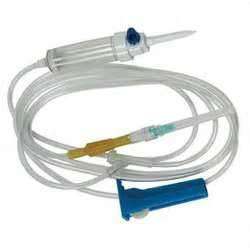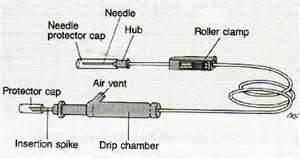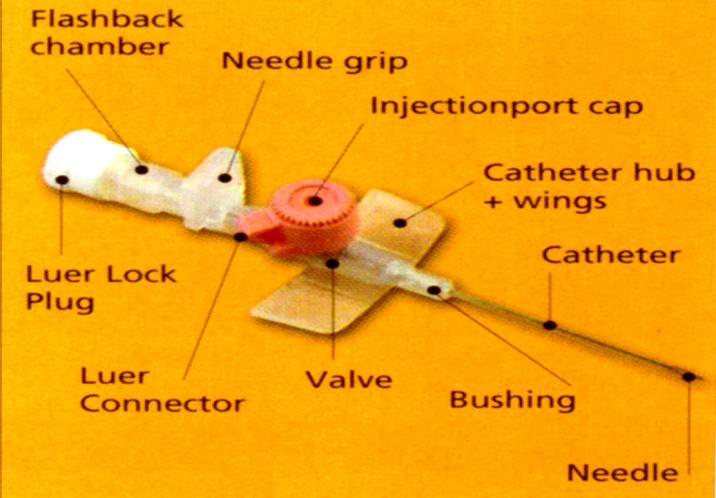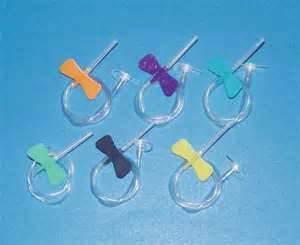Intravenous (IV) Therapy Equipments
Intravenous (IV) Therapy Equipments

- Intravenous solution containers
- Administration sets/flow rates
- IV stands
- Antiseptic solution (alcohol/Betadine) to cleanse skin
- IV needles or catheters
- Tape and site dressing materials
- Others
IV Solution Containers
Intravenous solutions are supplied in glass bottles and plastic bags. In order for the solution to flow out of a bottle, some solution bottles have a tube inside that serves as an air vent so that as the solution runs out of the bottle it is replaced by air. Bottle containers without air vents require a vent on the administration set. Air vents usually have filters to remove any contamination from the air which enters the containers. Because the plastic bag will collapse as fluid is removed, no air vent is needed. This prevents non-sterile air from coming in contact with the IV fluid. Both bottles and bags come in sizes ranging from 50 to 1000 milliliters of solution per container.
Administration Sets/Flow Rates
The conventional administration set consists of plastic tubing with a plastic spike that is inserted into the fluid container. This spike must be kept sterile. Below the spike is a drip chamber, which allows the rate of fluid administration to be monitored by counting the drops falling into the chamber. A roller valve or screw clamp is used to control the rate. The syringe tip (male adapter end of the tubing) fits into the hub of the needle in the vein. Most sets have one or more soft rubber entry ports (Y-ports) that reseal after puncture by a needle. These are used to inject medications into the IV line. If any other part of the plastic is punctured with a needle, a leak will occur.
The administration sets are constructed so that the orifice in the drip chamber delivers a predictable number of drops for each milliliter of fluid. The most common sets are called macrodrip sets. These deliver 10 to 20 drops per ml. Most manufacturers also supply microdrip sets. These sets deliver 50-60 drops per ml and can be identified by the fine metal orifice in the drip chamber. Blood administration sets are characterized by a larger lumen, which delivers fewer drops per ml, and a large built-in filter in the drip chamber, which removes any clots or precipitates in the blood.
Extension Tubing
Is simply a length of IV tubing with adapter on both ends to create longer tubing. Extension tubing is often added to allow a patient greater mobility.
An IV Stand, or pole, is used for hanging the solution container. Some poles are already attached to the hospital bed. Others stand on the floor or hang from the ceiling. The height of the rods is adjustable, and it is important to remember that the higher the solution container is suspended, the greater the force of the solution as it enters the patient and the faster the rate of flow.
Antiseptic SolutionsHaving an IV always poses an infection risk to the patient. To reduce this possibility, the skin must be prepared using antiseptic agents such as ethyl alcohol 70% lower the number of infection-causing organisms.

Figure 8.3 IV stand with IV solution and tubing |
  
Figure 8.4 Different types of Intravenous tube |
IV Needles and Catheters
The needle and catheter are among the most important of IV tools. The outside diameter of the needle shaft is called a gauge. The larger the gauge number, the smaller the diameter of the shaft. The inside diameter of the shaft is called the lumen.
The hub of an IV needle is the portion attached to the IV tubing or to a syringe. The bevel is the slanted edge at the end of the needle, with the tip being the longest portion of the slant and the heel being the shortest portion of the slant.
The winged-tip, or butterfly, needle comes in lengths of ½ inch to 1 ¼ inches, with diameters ranging from 25 gauge (G) to 17 G. The wings attached to the shaft are plastic or rubber, and the flexible tubing attached may be 3 to 12 inches long. Butterfly needles are usually used for infants or children, adults with small veins, or short-term therapy.
The IV cannula consists of a needle with a catheter fitted around it. The catheter is from 1 ¼ to 5½ inches long and from 12G to 24G in diameter. The point of the needle extends beyond the tip of the catheter. After venipuncture, the needle is withdrawn and discarded, leaving just the catheter in the vein.
Figure 8.5 Intravenous Canulla Size and Parts
 |
 |
Figure 8.6 Butter Fly Needles
 |
 |
Others
Tape and site dressing materials, tourniquet, glove, sharp container, arm support, needle and syringe. Clean injection tray containing the required equipments and drugs to be administered.